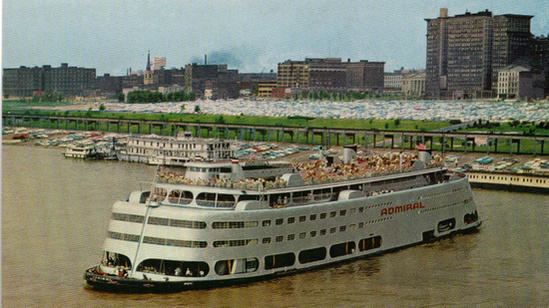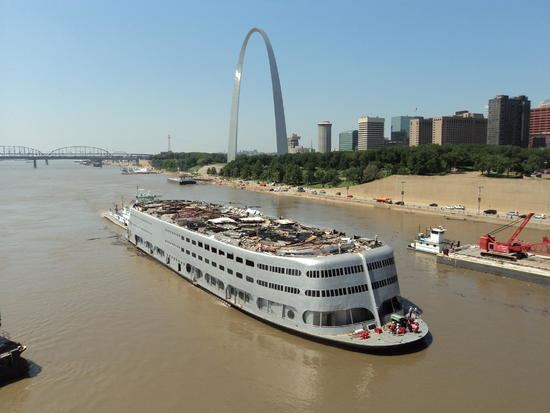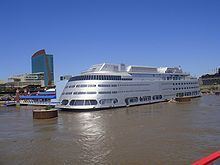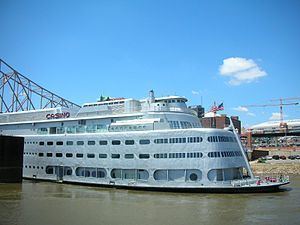Route Mississippi River In service 1940 Fate 2011 sold as scrap Launched 1907 | Acquired 1937 Out of service 1979 Beam 92 ft (28 m) Length 114 m | |
 | ||
Ss admiral
SS Admiral was an excursion steamboat operating on the Mississippi River from the Port of St. Louis, Missouri. The vessel had a 1930s streamlined, Art Deco style, similar to the MV Kalakala and in contrast to the "gingerbread" ornamentation of more traditional Mississippi passenger and pleasure steamers. At 374 feet (114 m) long and 92 feet (28 m) wide, Admiral was longer than a city block, and the first all-steel inland steamer. At the time of its construction, Admiral was the largest passenger vessel on U.S. inland waterways.
Contents
- Ss admiral
- 1973 st louis flood ss admiral steamboat 8mm
- Origin
- Construction
- Later history
- Accident
- 21st century history
- References

The boat was dismantled for scrap metal starting in 2011.
1973 st louis flood ss admiral steamboat 8mm
Origin

Throughout the 1920s, Streckfus Steamers operated the J.S. Deluxe, a palatial boat which cruised the Mississippi River from New Orleans to St. Paul, Minnesota. It brought exquisite service and fine musical entertainment to the area, introducing jazz to St. Louis.
Construction

In 1933 Streckfus Steamers decided to construct a new flagship. The boat was designed by Maizie Krebs for Captain Joe Streckfus. The young Krebs was a fashion illustrator for the St. Louis department store Famous-Barr, and neither she nor Streckfus originally took the design seriously, but she would also design another vessel for Streckfus, SS President, in 1934. The basis of Admiral was a ship built in 1907 for the Louisiana & Mississippi Valley Transfer Co. and operated at Vicksburg, MS Albatros. She was sold to Streckfus Steamers in 1937. From 1938 to 1940 Steamers Service Company rebuilt for more than $1,000,000 a ship with five decks, two of which were air-conditioned, an unheard-of luxury. Her steel hull was divided into 74 compartments, of which up to 11 could be flooded with the ship still remaining afloat. The new steel framework was designed and fabricated by Banner Iron Works.
Later history

She had a capacity of 4400 passengers, and departed on her first excursion cruise from the St. Louis waterfront in June 1940. For decades she was a familiar sight on the river.

In summers throughout the 1960s and 1970s, Admiral would cruise up and down the Mississippi River from 10am-3pm, with many families among the passengers. Older children would play pinball games on the noisy bottom deck where the giant steam engines and paddlewheel could be heard and seen from protected viewing areas. Above that deck, the entire second and third level was an open ballroom with a balcony around it. Tables and booths were all around the ballroom, and a stage and wooden dance floor near the center of the deck served as a place for bands to play, parents and grandparents to waltz and polka, and once in awhile a dance school to perform its annual recital. The ballroom was air-conditioned, a real treat in July summers on the Mississippi, but upstairs, on the open air sitting deck or on the very top, one could watch the shoreline of the Mississippi and the huge barges go by, while listening to a steam calliope playing traditional music.

In the winter of 1973/74 she was converted to diesel-props, with a total of 2,700 hp (2,000 kW) (three engines, one in each paddle box and one at the stern).
S.S. Admiral Partners bought the boat and completed a $30-million-plus renovation (The engines had been removed in 1979 and stripping the interior of much of its art deco trim and fittings). In the late 1980s, the boat was operated by Six Flags, which decided to shut the venture down due to high costs. Since the early 1990s it was operated from moorings near Eads Bridge as the President Casino Laclede's Landing. It boasted 1,230 slot machines, 59 gaming tables, 18 restrooms, and one restaurant.
Accident
About 7:50 pm on 4 April 1998, a tow of the M/V Anne Holly, comprising 12 loaded and two empty barges, which was traveling northbound on the Mississippi River through the St. Louis Harbor, struck the Missouri-side pier of the center span of the Eads Bridge. Eight barges broke away from the tow and drifted back through the Missouri span. Three of these barges drifted toward Admiral. The drifting barges struck Admiral, causing 8 of its 10 mooring lines to break. Admiral then rotated clockwise downriver, away from the Missouri riverbank. The captain of Anne Holly disengaged his vessel from the six remaining barges in the tow and placed Anne Holly's bow against Admiral's bow to hold it against the bank. About the time Anne Holly began pushing against Admiral, Admiral's next-to-last mooring line parted. Anne Holly and the single mooring wire that remained attached to Admiral's stern anchor held Admiral near the Missouri bank. No deaths resulted from the accident; 50 people were examined for minor injuries. Of those examined, 16 were sent to local hospitals for further treatment. Damages were estimated at $11 million. The quick response of the tow captain and emergency services prevented what might have been one of the most deadly marine disasters in history. The Mississippi River was over flood stage at the time of the accident and the ship would not have cleared the I-64 bridge just downstream. There were over 3000 people on board at the time. If Admiral had capsized when striking the bridge there would have been many people either trapped inside the flooding ship or in the frigid and turbulent river in the dark.
21st century history
In June 2005, it was reported that Columbia Sussex Corp. wanted to buy the President Casino on Admiral and replace it with a new vessel.
In August 2008, Pinnacle Entertainment, the owner, was considering moving the boat north to the area near the Chain of Rocks Bridge. After the state refused to approve the deal, Pinnacle surrendered its gambling license and sold to St. Louis Marine in 2010. The top deck was removed. The complete dismantlement was delayed because the 2011 Mississippi River floods made it impossible to transport it downstream under the Eads Bridge. With the water dropping, St. Louis Marine announced plans on July 17, 2011 to move it to Columbia, Illinois where the hull was dismantled and sold for scrap.
